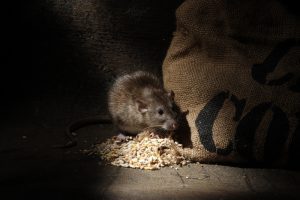MICE AND RATS CAN HARBOR BITING MITES
By Chris Williams on December 26, 2018.

House mouse with her young in a nesting area. Shutterstock.
You may know that rats and mice can carry various diseases and can sometimes transmit them to humans through their droppings, urine, and other bodily fluids. Did you know that rodents can also have parasites such as fleas, mites, lice, and ticks, and that these sometimes affect people as well? Apparently if you ever combed a rat, you would stand a very good chance of finding mites, at the very least!
In the pest control business, we sometimes run across situations where rodent mites are biting people. Rodent mites (there are several different species) are very tiny, barely visible to the naked eye, and easily overlooked. In structures, they are most often found on the bodies of mice or rats, in their nests, or nearby in wall voids or attics. Generally, these parasites stay on or near the rats or mice that they are infesting. Periodically, they will suck blood from the rodents, especially when there are young rodents in the nest.
ARE RODENT MITES A THREAT TO PEOPLE?

Norway rat with a bag of grain. Shutterstock.
Why are these rodent-specific mites trying to feed on people or pets instead? This only happens in unusual situations and is only a temporary issue since people, and even pets, are not good hosts for rodent mites for various reasons. Rodent mites don’t live for more than several days if they can’t feed on rats or mice. When rodent mites bite people instead, tiny clear blisters can result, accompanied by an itchy rash. Rodent mites might bite, or attempt to bite, people in the following situations:
- When a major infestation of mice or rats has been eliminated from a structure, either by the efforts of a professional exterminator, or by renovation, or some other change in circumstances. Suddenly mites that were living in the rodents’ nest or in wall voids or crevices nearby have no live animals to feed on. They will wander, looking for new hosts.
- When the infestation of mites has grown too large for the nest and there are no longer enough rodents to sustain it. This usually happens after young rodents have grown and left the nest. Mites may move on, looking for new more available hosts, and may wander into new areas. They might congregate around heat sources such as stoves, hot pipes, or electrical appliances. They usually feed at night.
- When handling dead rodents. Mites may transfer from their dead host to the next warm body they contact. They don’t stay long on a dead rodent, however. By the time the body cools, they have probably moved on. Wear gloves if you are handling dead mice.
- When people, usually children, own pet rodents (also gerbils and hamsters) that are infested with mites. Handling mite-infested rodents and cleaning their cages can cause itchy skin dermatitis in some people.
NO RODENTS…NO CHANCE OF RODENT MITES
Living with mice or rats in or around your home is never a good idea. You might think that the little mouse that just ran behind your stove is cute…but she probably has mites, and she’s probably heading for her nest in the wall void with babies and even more mites.
The good news is that being bitten by rodent mites is not a common occurrence in normal circumstances, the mites rarely transmit disease, and they don’t reproduce or live long when away from their rodent hosts. Rodent mites may bite people but they don’t infest people.
The best control for rodent mites is prevention of rodents in the first place. Give Colonial Pest a call and let us rid your home of rodents and their parasites. No rodents in your home, no worries about rodent mites!